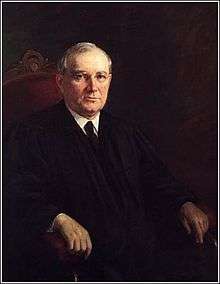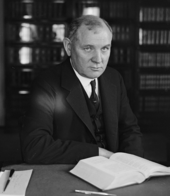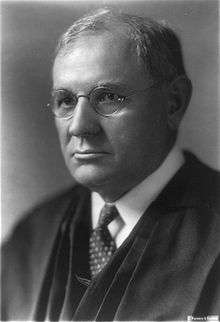Pierce Butler (justice)
| Pierce Butler | |
|---|---|
 | |
| Associate Justice of the Supreme Court of the United States | |
|
In office December 21, 1922 – November 16, 1939[1] | |
| Nominated by | Warren Harding |
| Preceded by | William Day |
| Succeeded by | Frank Murphy |
| Personal details | |
| Born |
March 17, 1866 Dakota County, Minnesota, U.S. |
| Died |
November 16, 1939 (aged 73) Washington, D.C., U.S. |
| Political party | Democratic |
| Spouse(s) | Annie Cronin |
| Alma mater | Carleton College |
| Religion | Roman Catholicism |
Pierce Butler (March 17, 1866 – November 16, 1939) was an American jurist who served as an Associate Justice of the Supreme Court of the United States from 1923 until his death in 1939. He is notable for being the first Justice from Minnesota, and for being a Democrat appointed by a Republican president, Warren G. Harding.
Early life and education
Butler was born to Patrick and Mary Ann Butler, Catholic immigrants from County Wicklow, Ireland. (The pair met in Galena, Illinois, after having left the same part of Ireland because of the Irish Potato Famine.) Soon, the couple settled in Sciota, then Waterford, Dakota County, Minnesota. Their son Pierce Butler was the sixth of nine children born in a log cabin; all but his sister would live to adulthood.
Butler graduated from Carleton College, where he was a member of Phi Kappa Psi Fraternity. He read for the law and was admitted to the bar in 1888. He married Annie M. Cronin in 1891.
Career
He was elected as county attorney in Ramsey County in 1892, and re-elected in 1894.[2] Butler joined the law firm of How & Eller in 1896, which became How & Butler after the death of Homer C. Eller the following year. He accepted an offer to practice in St. Paul, Minnesota, where he took care of railroad-related litigation for James J. Hill. He was highly successful in representing railroads.[3]
In 1905 he returned to private practice and rejoined Jared How. He had also served as a lawyer for the company owned by his five brothers. In 1908, Butler was elected President of the Minnesota State Bar Association.
From 1912 to 1922, he worked in railroad law in Canada, alternately representing the shareholders of railroad companies and the Canadian government; he produced favorable results for both. When he was nominated for the United States Supreme Court in 1922, Butler was in the process of winning approximately $12,000,000 for the Toronto Street Railway shareholders.
Nomination and confirmation

Although he was supported by Chief Justice and former President William Howard Taft, Butler's opposition to "radical" and "disloyal" professors at the University of Minnesota (where he had served on the Board of Regents) made him a controversial Supreme Court nominee when proposed by Republican President Warren Harding. The Senator-elect Henrik Shipstead of his home state opposed him, as did the Progressive Senator Robert M. LaFollette, Sr. of Wisconsin.[3] Also against his confirmation were labor activists, some liberal magazines (The New Republic and The Nation) and the Ku Klux Klan because he was Catholic. However, with the support of prominent Roman Catholics, fellow lawyers (the Minnesota State Bar Association strongly endorsed him), and business groups (especially railroad companies), as well as Minnesota's other senator Knute Nelson, Butler was confirmed on Dec 21, 1922, by a wide margin of 61 to 8. The Senators who voted against him were five Democrats (Walter F. George, William J. Harris, J. Thomas Heflin, Morris Sheppard, and Park Trammell) and three Republicans (Robert M. LaFollette, Sr., Peter Norbeck, and George W. Norris). He took his seat on the Court on January 2, 1923.[4][5]
Court service

As an Associate Justice, Butler vigorously opposed regulation of business and the implementation of welfare programs by the federal government (as unconstitutional). During the Great Depression, he ruled against the constitutionality of many "New Deal" laws— the Agricultural Adjustment Administration and the National Recovery Administration— which had been supported by his fellow Democrat Franklin Roosevelt.[3] This earned him a place among the so-called "Four Horsemen," which also included James Clark McReynolds, George Sutherland, and Willis Van Devanter.[3][6] During his sixteen years on the bench, Justice Butler authored 327 majority opinions as well as 50 eloquent minority opinions. On November 15, 1939, Butler went into the hospital for "a minor ailment" but died in the early morning hours of November 16.
He wrote the majority opinion (6-3) in United States v. Schwimmer, in which the Hungarian immigrant's application for citizenship was denied because of her candid refusal to take an oath to "take up arms" for her adopted country.
In Palko v. Connecticut, Butler was the lone dissenter on the court; the rest of the justices believed that a state was not restrained from trying a man a second time for the same crime. Butler believed this violated the Fourteenth Amendment to the United States Constitution.
He sided with the majority in Pierce v. Society of Sisters, holding unconstitutional an Oregon state law which prohibited parents from sending their children to private or religious schools.[6]
In Buck v. Bell, Butler was the only Justice who dissented from Justice Oliver Wendell Holmes, Jr.'s opinion holding that the forced sterilization of an allegedly "feeble-minded" woman in Virginia was constitutional.[7] Holmes believed that Butler's religion influenced his thinking in Buck, remarking that "Butler knows this is good law, I wonder whether he will have the courage to vote with us in spite of his religion."[8] Although Butler dissented in both Buck and Palko, he did not write a dissenting opinion in either case;[9] the practice of a Justice's noting a dissent without opinion was much more common then than it would be in the later 20th and early 21st centuries.
Another consequential dissent was from the opinion expressed in Olmstead v. United States which upheld federal wiretapping.[6] He took an expansive view of 4th Amendment protections.[5]
Death and legacy

Butler died in Washington, D.C., at the age of 73 while still on the court. He is buried in the Calvary Cemetery in St. Paul.[10][11]
Justice Butler is one of 13 Catholic Justices – of 112 total Justices in the history of the Supreme Court.[12][upper-alpha 1]
40.5 cubic feet (1.15 m3) of his and his family's collected papers are with the Minnesota Historical Society.[13][14] Other papers are collected elsewhere.[14]
Pierce Butler Route[15] in Saint Paul, Minnesota, is named in honor of Butler.
See also
- List of Justices of the Supreme Court of the United States
- List of law clerks of the Supreme Court of the United States
- List of U.S. Supreme Court Justices by time in office
- United States Supreme Court cases during the Hughes Court
- United States Supreme Court cases during the Taft Court
Bibliography
Footnotes
- ↑ See Demographics of the Supreme Court of the United States. (Justice Sherman Minton converted to Catholicism after his retirement.)
References
- "Pierce Butler". Federal Judicial Center.
- Danelski, David J. (1964). A Supreme Court Justice is Appointed. New York: Random House. p. 242.
- Stras, David R. (August 26, 2008). "Pierce Butler: A Supreme Technician" (pdf (full paper downloadable)). Vanderbilt Law Review. 62. Retrieved July 24, 2012.
- Fernandes, Ashley K. (2002). "The Power of Dissent: Pierce Butler and Buck v. Bell". Journal for Peace and Justice Studies. 12 (1): 115–134.
Notes
- ↑ "Federal Judicial Center: Pierce Butler". 2009-12-12. Retrieved 2009-12-12.
- ↑ "Pierce Butler". Supreme Court Historical Society. Retrieved July 24, 2012.
- 1 2 3 4 "Pierce Butler". Encyclopædia Britannica. Encyclopædia Britannica Online. Encyclopædia Britannica Inc. 2012. Retrieved July 24, 2012.
- ↑ "Pierce Butler". Federal Judicial Center.
- 1 2 "Pierce Butler". Oyez.org. Retrieved July 24, 2012.
- 1 2 3 Ariens, Michael. "Pierce Butler". Michael Ariens. Retrieved July 24, 2012.
- ↑ Thompson, Phillip (February 20, 2005). "Silent Protest: A Catholic Justice Dissents in Buck v. Bell" (pdf). Catholic Lawyer. 43 (1): 125–148. Retrieved July 24, 2012.
- ↑ Leuchtenburg, William E. (1995). "Mr. Justice Holmes and Three Generations of Imbeciles". The Supreme Court Reborn: The Constitutional Revolution in the Age of Roosevelt. New York: Oxford University Press. p. 15. ISBN 0195086139.
- ↑ Fernandes, Ashley K. (2002). "The Power of Dissent: Pierce Butler and Buck v. Bell". Journal for Peace and Justice Studies. 12 (1): 115–134.
- ↑ Christensen, George A. (1983) Here Lies the Supreme Court: Gravesites of the Justices, Yearbook at the Wayback Machine (archived September 3, 2005). Supreme Court Historical Society at Internet Archive.
- ↑ Christensen, George A., Here Lies the Supreme Court: Revisited, Journal of Supreme Court History, Volume 33 Issue 1, Pages 17 – 41 (Feb 19, 2008), University of Alabama.
- ↑ "Religious affiliation of Supreme Court justices". Retrieved July 24, 2012.
- ↑ Johnson, Kathryn A. (July 1991). "Pierce Butler papers" (pdf). Minnesota Historical Society. Retrieved July 24, 2012.
- 1 2 "Pierce Butler, Research collections". Federal Judicial Center. Retrieved July 24, 2012.
- ↑ "Pierce Butler Route".
Further reading
- Abraham, Henry J. (1992). Justices and Presidents: A Political History of Appointments to the Supreme Court (3rd ed.). New York: Oxford University Press. ISBN 0-19-506557-3.
- Abraham, Henry J. (1999). Justices, Presidents, and Senators: A History of the U.S. Supreme Court Appointments from Washington to Clinton (Revised ed.). Lanham: Rowman & Littlefield. ISBN 0-8476-9604-9.
- Cushman, Clare (2001). The Supreme Court Justices: Illustrated Biographies, 1789–1995 (2nd ed.). (Supreme Court Historical Society, Congressional Quarterly Books). ISBN 1-56802-126-7.
- Frank, John P. (1995). Friedman, Leon; Israel, Fred L., eds. The Justices of the United States Supreme Court: Their Lives and Major Opinions. Chelsea House Publishers. ISBN 0-7910-1377-4.
- Hall, Kermit L., ed. (1992). The Oxford Companion to the Supreme Court of the United States. New York: Oxford University Press. ISBN 0-19-505835-6.
- Martin, Fenton S.; Goehlert, Robert U. (1990). The U.S. Supreme Court: A Bibliography. Washington, D.C.: Congressional Quarterly Books. ISBN 0-87187-554-3.
- Schroeder, David (2009). More Than a Fraction: The Life and Work of Justice Pierce Butler (pdf). Dissertations (1962 - 2010). Marquette University. Retrieved August 14, 2012. Access via Proquest Digital Dissertations. Paper AAI3357971.
- Schroeder, David (July 13, 2010). "Joining the Court: Pierce Butler" (pdf). Journal of Supreme Court History. 35 (2): 144–165. doi:10.1111/j.1540-5818.2010.01238.x.
- Urofsky, Melvin I. (1994). The Supreme Court Justices: A Biographical Dictionary. New York: Garland Publishing. p. 590. ISBN 0-8153-1176-1.
External links
| Wikisource has original works written by or about: Pierce Butler |
| Wikimedia Commons has media related to Pierce Butler (1866-1939). |
- Pierce Butler at the Biographical Directory of Federal Judges, a public domain publication of the Federal Judicial Center.

- Pierce Butler at Find a Grave
| Legal offices | ||
|---|---|---|
| Preceded by William Day |
Associate Justice of the Supreme Court of the United States 1922–1939 |
Succeeded by Frank Murphy |
| | |||||||||||||||||||||||||
|---|---|---|---|---|---|---|---|---|---|---|---|---|---|---|---|---|---|---|---|---|---|---|---|---|---|
|
 | ||||||||||||||||||||||||